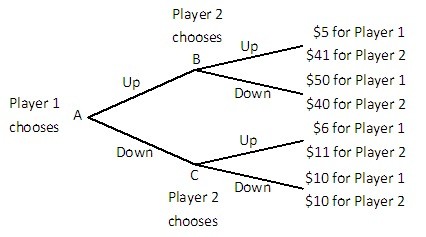 According to the above table, if the wage rate is $400 a week and the price of the good produced is $5, the perfectly competitive firm should hire
According to the above table, if the wage rate is $400 a week and the price of the good produced is $5, the perfectly competitive firm should hire
A. 3 workers.
B. 4 workers.
C. 5 workers.
D. 6 workers.
Answer: B
You might also like to view...
Player 1 and Player 2 are playing a game in which Player 1 has the first move at A in the decision tree shown below. Once Player 1 has chosen either Up or Down, Player 2, who can see what Player 1 has chosen, must choose Up or Down at B or C. Both players know the payoffs at the end of each branch.  If Player 2 could make a credible commitment to choose either Up or Down when his or her turn came, then what would Player 2 do?
If Player 2 could make a credible commitment to choose either Up or Down when his or her turn came, then what would Player 2 do?
A. Player 2 would commit to choosing Down. B. Player 2 would commit to choosing Up. C. Player 2 would not commit to choosing either strategy. D. Player 2 would commit to mimicking Player 1's strategy.
In the game in Scenario 13.14,
A) R's dominant strategy is Q = 100; C has none. B) C's dominant strategy is Q = 100; R has none. C) Q = 100 is a dominant strategy for both R and C. D) Q = 100 dominates Q = 150 for both firms. E) the dominant strategy for both players is to choose the same level of output, so long as it is not 150.
Some financial institutions are classified as depository institutions based on: a. the way they acquire funds
b. the number of customers they have. c. the number of loans they make. d. the size of the loans they make. e. the amount of reserves they hold.
In a market-oriented economy, the choice between the production of consumer goods and physical capital is the result of decisions made by: a. the government
b. firms and the government. c. households and firms. d. the labor force.